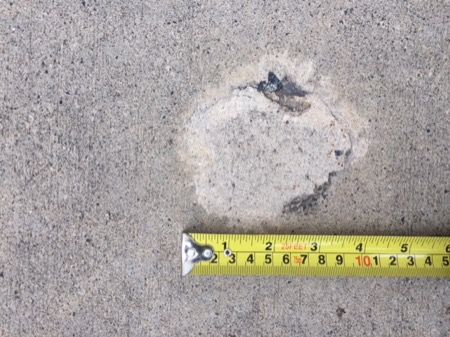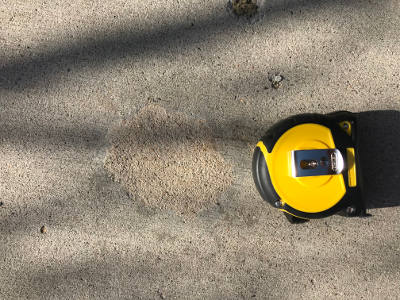Before I talk about mud jacking, I have to remind you we do poly foam jacking, so we have a bias.
But we have that bias for a reason, we definitely, positively, absolutely believe that using foam is a better solution than mud jacking, and here’s the two biggest reasons why!
Mud Jacking Issue One

From a curb appeal standpoint the biggest challenge of mud jacking is the patches that are left behind.
Especially with older concrete!
The actual hole size for injecting the mud is only around 1 5/8″, but when you’re dealing with drilling concrete there is inevitably some chipping at the entry point which makes the hole slightly larger. If the concrete is older, it can often lead to even more chipping on the surface which leaves you a patch almost four inches across, like in this image.
Now, if this is a driveway in your backyard, or a sidewalk that’s rarely used down the side of your property it might not be an issue.
If however, it’s right out front and is your main access to your home it does become a bit of an eyesore. Additionally if it’s a full concrete slab it will likely need three, four, maybe even five or six of these holes allowing the mud to be injected evenly.
When you compare this to the injection holes when using polyurethane foam which are only 5/8″ you can see why we prefer poly from an aesthetics viewpoint.
Mud Jacking Issue Two

The second issue we have with using a mud/concrete slurry to raise or level your concrete is the weight of the product.
The main reason your sidewalks or driveway is sinking is normally due to the ground underneath not being stable. Often, especially around new home builds, the ground isn’t packed in sufficiently and over time it settles into place creating voids underneath the concrete.
If the voids underneath the concrete slab are closer to the corners or the ends of a slab, this can lend a slab to tilting as the ground shifts under that area due to the weight of the slab. As the one end dips down, the other end of the slab starts raising upwards or in some situations starts to crack as the weight becomes to excessive.
Neither of these situations are good for your property!
Which brings up this point, if all this settling is exasperated due to the weight of the concrete slab, why would you want to add more weight to the situation?
The mixture of mud and concrete used in mud jacking ends up weighing around 100 lbs per cubic foot. If you’re dealing with a large void, you’re dealing with a ton of extra weight (not to be confused with a tonne of weight as in the measurement, but more of an expression of a lot!),
Compare this with polyurethane foam which weighs in at 2 lbs per cubic foot (hence our favourite hashtag #2lbfoamislife) and you can see why we prefer foam!
This weight issue is such a problem it’s very common for mud jacking to have to be repeated within a couple years as the additional weight leads to additional settling which leads to additional mud being required. What a predicament!
So, Foam Or Mud?
We’ve outlined a couple reasons why we’re big fans of foam jacking versus mud jacking, but as we mentioned we’re biased.
Ultimately the choice is up to you, the customer, which product you’d prefer. The priority being getting your uneven concrete fixed as soon as possible of course.
So to help with that, we’d absolutely love to come out and give you a free quote on getting your concrete sidewalk, driveway or patio levelled.
Why not find out your options. We’ll come out, do some measurements, inspect the surrounding area and typically be able to give you an estimate while we’re there. We can even come by while you’re at work and email it to you later in the day!
To get started, simply follow this link, Foam Jacking Quote and we’ll contact you as soon as possible to coordinate a site visit and update you on your options. So don’t wait, contact us today!

